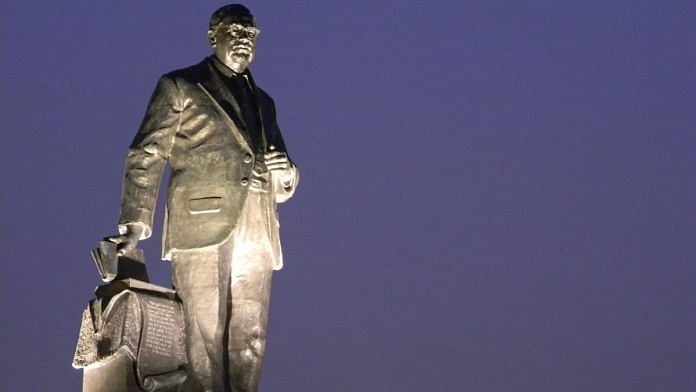For the BJP, it’s easier to reduce B. R. Ambedkar to symbols and statues than deal with the entire complexity of his legacy.
It’s a crying shame that most Indians go through their education system learning too little about B.R. Ambedkar beyond that ‘Father of the Indian Constitution’ title.
Ambedkar should be a far more towering figure in the history of modern India than he is. That could require rewriting some of that history that has been handed down to us. But the Uttar Pradesh government seems more focused on rewriting his name.
Babasaheb Ambedkar will henceforth be known officially as Bhimrao Ramji Aambedkar in all UP documents and records on the recommendation of UP governor Ram Naik.
The ‘Ramji’ is the middle name as derived from his father’s name. The Aambedkar is in keeping with the pronunciation of the last name.
Technically, the government is correct. That is how Ambedkar signed the second page of the chapter on the Eighth Schedule of the Indian Constitution. He signed that in Hindi.
In that same Constitution, just a few signatures down from Amrit Kaur and Vallabhbhai Patel and Jagjivan Ram, he again signs his name in English as B.R. Ambedkar.
Before he converted to Buddhism, Ambedkar had said “Though I was born a Hindu, I solemnly assure you I will not die as a Hindu.” But now, more than 60 years after his death, by cherry-picking a version of his name that suits it, the UP government is not righting any historical wrong in as much as trying to organise a ghar wapsi for Ambedkar into mainstream Hinduism.
The government can claim it is playing by the book or at least by the signature. It’s not rewriting history, just restoring something that was always there. The question is did Ambedkar ever insist on the Ramji being emphasised in his name. Was this some kind of truncation that had happened against his will, an elision of his natural identity that had been imposed upon him after his death?
If not, why is Ram Naik so bothered? Also, if Ambedkar was content to be Ambedkar in English and Aambedkar in Hindi, why is the government hellbent on “fixing” that? Rabindranath Tagore has always been Tagore in English and Robindranath Thakur in Bengali and that has not diminished his lustre one bit.
If we want to return to some Middle Kingdom of middle names, why not insist that Narendra Modi should always be referred to as Narendra Damodardas Modi in all official communications. But there is nothing to be gained by that unlike in Ambedkar’s case. Rajiv Gandhi should become Rajiv Ratna Gandhi. If we are to become a stickler for full names across the board and B.R. Ambdekar needs to always be Bhimrao Ramji Aambedkar, then H. D. Deve Gowda should only be referred to as Haradanahalli Doddegowda Deve Gowda and A.P.J. Abdul Kalam should always be referenced in full as Avul Pakir Jainulabdeen Abdul Kalam. But there’s no great demand for that.
What’s in a name? Plenty. The BJP’s Subramanian Swamy and his followers realised this a long time ago when they insisted on calling Sonia Gandhi Sonia Maino. By doing that, Swamy wanted to keep her foreign roots front and centre.
The “rediscovery” of the Ramji in Babasaheb Ambedkar is the flipside of the same coin. If Sonia Maino was a way to distance Sonia Gandhi from India, Bhimrao Ramji Ambedkar is a way to draw B.R. Ambedkar and his followers closer into the BJP’s mothership. And just in time as well. On 14 April, Narendra Modi is all set to inaugurate the Ambedkar Memorial, sorry the Aambedkar Memorial in Delhi. Last year, he had inaugurated the Ambedkar International Centre. Modi has called Ambedkar the equivalent of Dr Martin Luther King Jr and described himself as the “bhakt of Babasaheb” conveniently omitting the fact, as Ramchandra Guha has pointed out, that in 1949 alone, the RSS held 79 rallies where they burned Ambedkar and Nehru in effigy.
The truth of Ambedkar is complex. Ambekar is on record as having said “If Hindu Raj does become a fact, it will no doubt be the greatest calamity for this country.”
As S.N.M. Abdi noted he first entered the Constituent Assembly thanks to the Muslim League in Bengal, not even to the Congress because his views on Dalits not being Hindus made him persona non grata with the Congress.
At a time when four professors at an elite institute like IIT Kanpur are found guilty of harassing a Dalit colleague; a time when a caste survey by Equality Labs in the United States says two out of three Dalits surveyed report being treated unfairly in the workplace and one in three report discrimination during education; when there is a debate about whether the “creamy layer” should be prevented from accessing SC/ST reservation benefits and Dalit MLAs are in an uproar about a perceived dilution of the Scheduled Castes and Scheduled Tribes (Prevention of Atrocities)Act by the Supreme Court — the correct spelling of Ambedkar’s name surely ranks quite low in the list of pressing issues facing Dalits.
However, it’s far easier to reduce political leaders to symbols and statues than deal with the entire complexity of their legacy. Mayawati filled the parks of UP with statues of Ambedkar, Kanshi Ram and herself to convey the message that the Dalit power had arrived. Now, by making him officially Bhimrao Ramji Ambedkar, the new dispensation shorthands its kinship with the Dalit leader.
And what excellent timing to rediscover the Ramji in B.R. Ambedkar. The BJP has big ticket items planned for Uttar Pradesh, including a 100-metre high statue of Lord Rama costing Rs 330 crore on the banks of the Saryu, a 7D Ramlila and Ramkatha gallery.
With the rediscovery of the Ramji in his name, B.R. Ambedkar, the Dalit icon will fit in perfectly into this glittering Ram Rajya.
Sandip Roy is a journalist, commentator and author.



